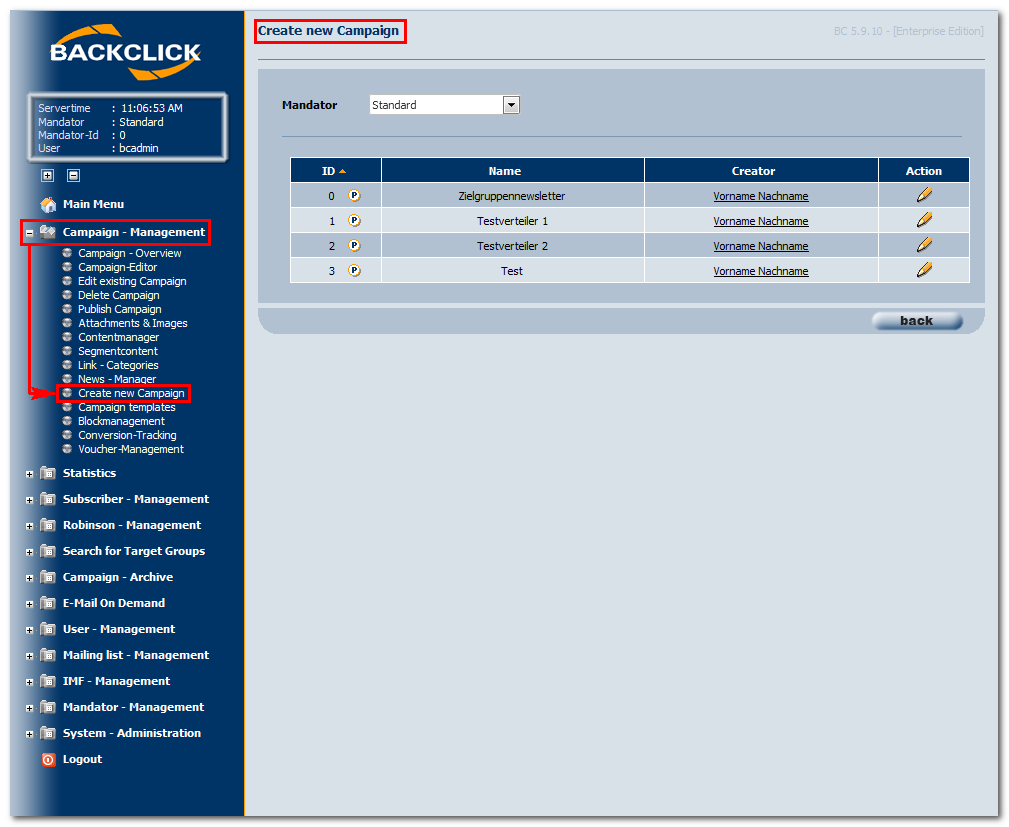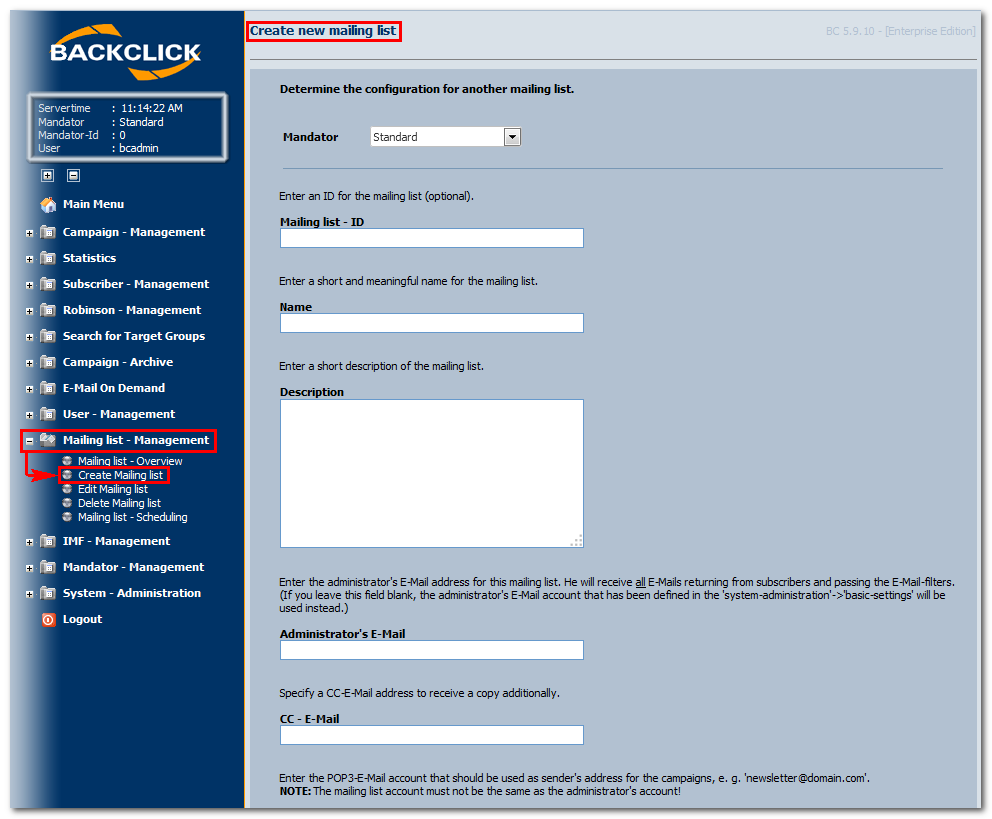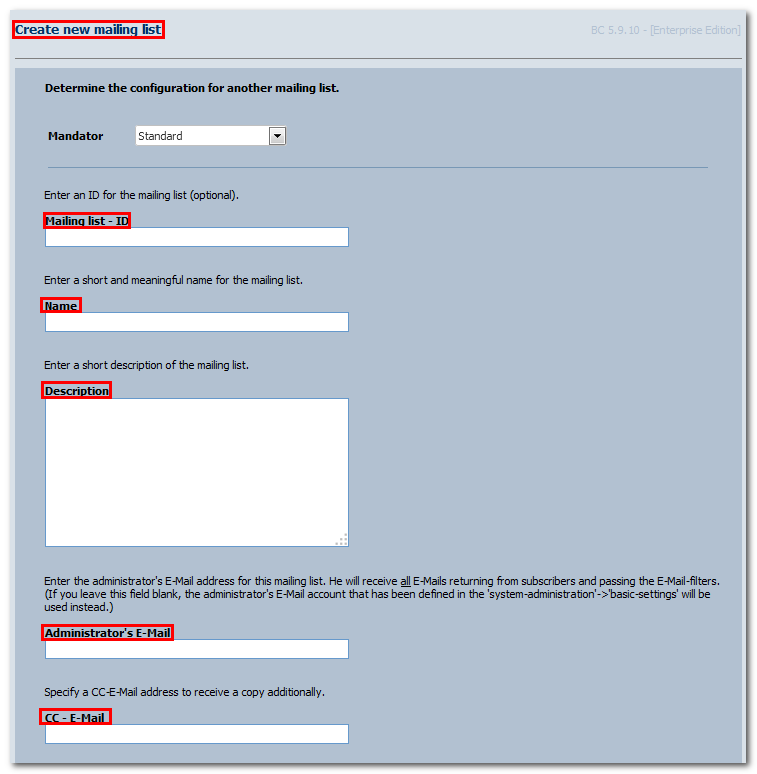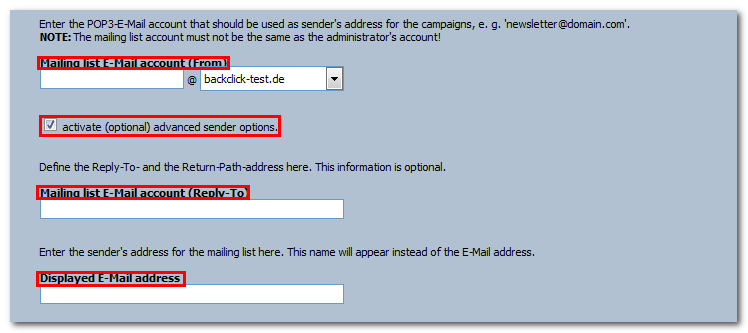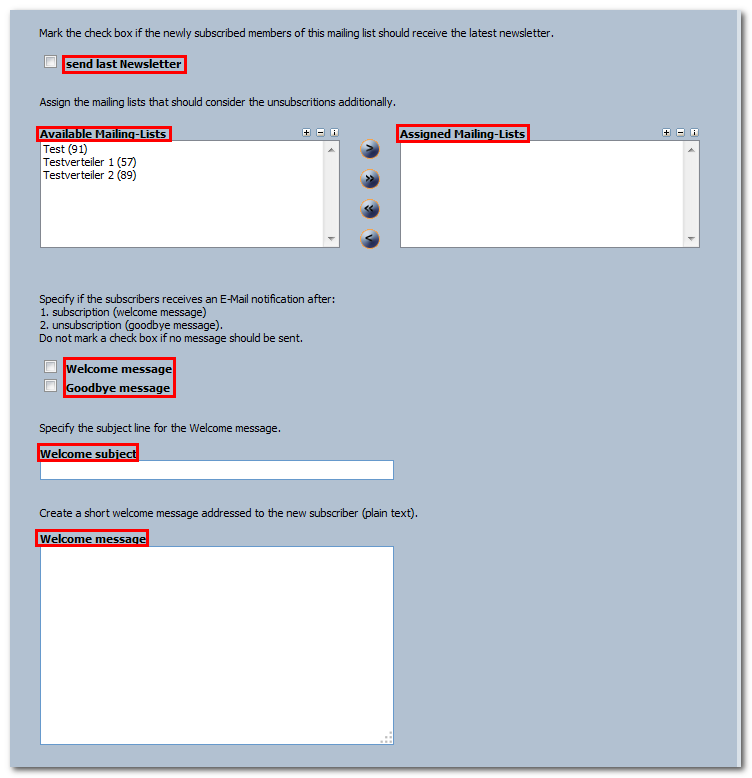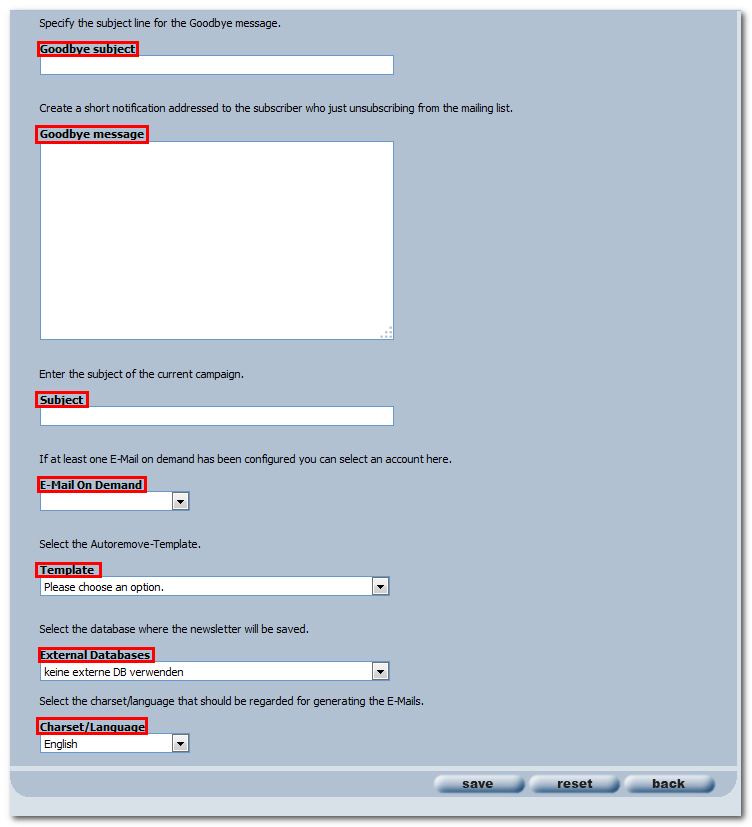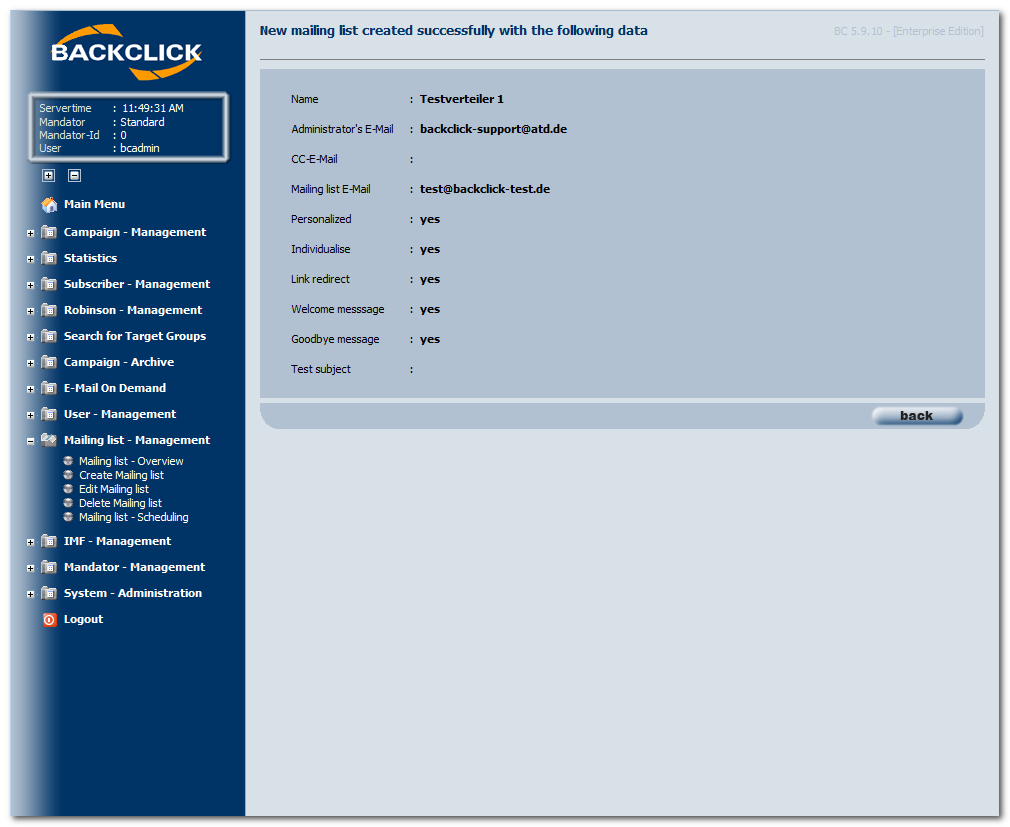In BACKCLICK every subscriber has to be part of at least one mailing list. By means of this belonging it is possible to send a newsletter or a campaign to a specific mailing list. Only after a mailing list is created, subscribers may subscribe, unsubscribe or change their profile using the WebInterface. Likewise, users cannot create or import subscribers until a mailing list is configured.
In order to see whether your administrator has already created the required list(s), look at the menu item Campaign - Management -> Create new Campaign. The corresponding list(s) available to create a newsletter will be displayed.
Creating a new mailing list is not necessary in this case and you may switch to the chaper Create the first subscriber.
Fig. 3.2 - Create new Campaign (Example with mailing lists available)
If there is no mailing list available you have to create a new one in BACKCLICK. Choose the menu item Mailing list - Management -> Create Mailing list.
The first mailing list you create will get the ID 1, the second one will get the ID 2, and so on. These IDs will be important for importing data and creating your HTML templates for subscription and unsubscription.
After choosing the menu item Create Mailing list you will see the following screen:
Figure 3.2.1 — Create mailing list (without input)
Before you get started, the following information have to be available:
- E-mail address that will be shown as the sending E-Mail address.
- Alternative name that will be shown as the sender's name in the E-Mail client of the subscriber.
- E-Mail address of the administrator that recieves the returned E-Mails that could not be handled automatically
- E-Mail address of the deputy administrator that recieves the returned E-Mails that could not be handled automatically as well (optional)
- POP3 access information for the account of the sender's E-Mail address (username, password, host, port)
- SMTP server that is in charge of sending the e-mails (host, port, possibly user, password)
All input possibilities are described below.
Figure 3.2.1.1 — Create mailing list (Input example, Part 1)
Mailing list ID
Optionally, you may provide an ID yourself, in case this is useful for sorting purposes. If this field is left blank, BACKCLICK will generate sequenced IDs for all mailing lists created automatically. This ID is based on the moment the mailing list is saved.
Name
This name is displayed in the administrator interface of BACKCLICK. You may change it at any time.
Description (optional)
You may enter a description for your mailing list here. It will only be displayed when you are editing this list.
Administrator's E-Mail
Enter the E-Mail address of the administrator that is supposed to be responsible for this mailing list here. He will receive all E-Mails that are sent back to the distributor account by subscribers and could not be filtered automatically.
CC - E-Mail (optional)
You may define a CC - E-Mail address that receives a copy of these administrator E-Mails.
Figure 3.2.1.2 — Create a mailing list (Input example, Part 2)
Mailing list - E-Mail account
Enter the senders E-Mail address to be used for sending E-Mails to this mailing list. This E-Mail address is displayed as the "Received from" E-Mail address to the subscribers. NOTE: This account cannot be identical with the administrator account.
Activate advanced sender options
If the advanced-sender options are activated, you may define additional mailing list E-Mail account addresses for Reply To and Return Path.
- Reply-To: The E-Mail address that receives reply E-Mails. Every reply the subscriber sends by clicking the 'Reply' button will be sent to this E-Mail address.
- Return-Path: The E-Mail address that receives E-Mails returned due to unavailability or non-existence of the subscriber's E-Mail address. Like described in the interface, bare in mind that the SMTP server defines these E-Mail addresses itself. If you enter an E-Mail address here, double-check if it is the same address as on your SMTP server afterwards.
Displayed E-Mail address
You may enter an alternative sender's name for the mailing list here. This name will be displayed to the recipient (subscriber) instead of the sender's E-Mail address (Mailing list - E-Mail account) depending on mail clients.
Mailing list - User name
Enter the username of the POP3 newsletter account of the sender's E-Mail address here. Username and password are used to receive and filter reply E-Mails automatically.
Mailing list - Password
Enter the password to the POP3 newsletter account of the sender's E-Mail address here.
POP3 - Server of the mailing list E-Mail account
Enter the POP3 serverhost for your POP3 newsletter account of the sender's E-Mail address here. If you do not provide a serverhost, BACKCLICK will try to use the local computer ("localhost") to receive E-Mails.
POP3-server timeout
Please define a timeout period for access to your POP3 server here. If a problem should occur while retrieving an E-Mail from the POP3 account, BACKCLICK terminates the call after this period of time. The timeout period can be anything from 1 to 30 seconds.
Fig. 3.2.1.3 - Create a mailing list (Input example, Part 3)
SMTP - Server #01 - #20
Enter one (or more) dedicated SMTP servers for this mailing list here. If you do not provide an SMTP server, BACKCLICK will try to use the local computer ("localhost") for dispatch. Enter the login details for the SMTP server as well if needed. BACKCLICK supports AMTP, which is used by web.de amongst others.
SMTP - Server Timeout
Please define a timeout period for access to your SMTP server here. If an error occurs while connecting to the SMTP server, BACKCLICK stops trying to connect after this period of time. The timeout period can be anywhere from 1 to 30 seconds.
PLEASE NOTE: While using the internal MTA, you will not see menu items:
- SMTP - Server #01 - #20 and
- SMTP - Server Timeout
because they are not used.
For further information, please read chapter BACKCLICK MTA.
Priority
You may define the priority to be used as default for this mailing list. This does not affect the speed of your dispatch but will be shown in your recipients mail client.
Personalization
If you activate Personalization, every subscriber will receive a personalized newsletter generated with personal data from BACKCLICKs database. Variables available include $$TITLE$$, $$LASTNAME$$ and others. You may add your own replacement characters as well, for example $$SIZEOFSHOES$$. Dispatch rate of personalized newsletters is approximately 100,000 to 1,500,000 E-Mails per hour. This rate may vary and it depends on your hardware, your connection, the number of SMTP servers and the size of the newsletter. Additionally, it is possible to activate Link - Redirect. This feature is available for 'mailto'-links as well.
Link - Redirect
This feature enables you to interpret your responses. When activating this feature, hyperlinks will automatically be replaced by BACKCLICK and redirected to the server where BACKCLICK is installed in order to be recorded in the statistical database. Without this activation, you will NOT be able to see any response data. If your links are not supposed to be changed in any way, please deactivate Link-Redirect. NOTE: BACKCLICK statistics will also be deactivated when doing so.
If Personalization is deactivated, Link-Redirect and Mailto Redirect are shown greyed out and you are not able to use/set those.
Fig. 3.2.1.4 — Create a mailing list (Input example, Part 4)
Individualization
Using this feature you may determine whether your newsletter content is supposed to be individual for every recipient. If you activate this feature, the content will be determined by pre-defined logics. NOTE: Do not activate this feature if you do not intend to use it, the computing time while sending a newsletter will be much higher. Dispatch rate of individualized newsletters is approximately 50,000 to 100,000 newsletters per hour.
Inline Images
Activating this feature enables you to send so called Offline HTML E-Mails. If you link pictures in your HTML newsletter (for example: http://www.domain.de/images/image.jpg), BACKCLICK will automatically download this picture from the internet and embed it into your newsletter. The advantage is that even newer E-Mail clients like AOL 9.0 or Outlook 2003 will display your E-Mails in the right format automatically without any further action of the subscriber. BACKCLICK is able to send gif/jpg pictures as inline images (meaning within the newsletter itself). Please bare in mind that the size of your newsletter will be alot bigger with inline images. You may deactivate this feature individually for each newsletter, even if you activated it previously.
Default format/Custom format
The following default formats are available:
If you do not find the format you need, please define a new one using 'Custom Format'. Click the symbol for help with the syntax. When choosing a new format this replaces your previous default settings for this list.
Activate IVW evaluation
To get an IVW-conformable count of the HTML newsletters opened, please activate this feature. You will need a so called SZM link, which you may obtain from IVW. At the time this documentation was created, IVW charges a fee for this service. Please read the instructions on their website.
Activate BACKCLICK's internal evaluation
BACKCLICK offers a similar version of the IVW evaluation free of charge. Activate this feature in order to use it. Please note that evaluation is only possible for HTML newsletters. The percental evaluation may be affected by factors like auto preview, HTML proxy server and deactivation of automated reloading of content on mailclient websites.
Activate response tracking and personalized analysis for market research purposes
BACKCLICK enables you to relate your subscriber's response data to their profile data in order to evaluate the responses individual-related. This data may be exported. NOTE: Every nation has its own data-protection laws. You may be liable for your data and its use.
Fig. 3.2.1.5 - Create a mailing list (Input example, Part 5)
Send last newsletter
If a subscriber subscribes via the WebInterface, this subscriber will automatically receive the last newsletter sent. This will only happen if this feature is activated, of course.
Mailing lists
If you want to remove the subscriber from other mailing lists as well after unsubscribing from this list allocate these other lists here.
PLEASE NOTE: This applies to automatic unsubscriptions done by the IMF filter ONLY!
Welcome/Goodbye message
When activated, an E-Mail confirmation will be sent to your subscribers upon subscribing to or unsubscribing from this mailing list. These procedures are called “confirmed-opt-in” and "confirmed-opt-out". If you already use the double-opt-in procedure, you do NOT have to activate this feature.
Welcome subject
This text will be displayed as subject of your welcome E-Mail.
Welcome message
The subscriber will receive this message after subscribing.
Fig. 3.2.1.6 - Create a mailing list (Input example, Part 6)
Goodbye subject
This text will be displayed as subject of your unsubscribe confirmation.
Goodbye message
The subscriber will receive this message after unsubscribing.
Subject
Enter the subject of your 'usual' newsletter. This will be your default subject for newly created newsletters. You may replace it with an up-to-date subject anytime.
Test - Newsletter - Subject
This is the subject of test newsletters which can be requested by subscribers via the WebInterface.
E-mail on demand
When receiving returns that could not be identified by the system automatically, you are able to send a reply to the sender using this feature. Please refer to chapter Email_on_demand for details.
Template
The Autoremove-Template offers subscribers an easy way to unsubscribe from your newsletter. You will find some editable example templates in delivery state. Additionally, you may create your own template. Please read chapter WebInterface - Templates for more information. This Select-Box shows all existing templates.
External databases
If an external database is configured, you may choose it here. Any newsletters sent using this mailing list will be stored there. Please read chapter “System Settings -> External Databases” for more information.
Charset/Language
Choose the charset and language for your newsletter in order to display special characters correctly.
If all settings are done and you want to save them, please click the "save" button. If all your input is correct and the POP3 and SMTP servers are available, you will see the following confirmation:
Fig. 3.2.2 - Mailing list created (Input example)
If an error message is shown, please follow the instructions to correct the issue.
If all settings are correct, you are now able to create the first subscriber in your system and add him/her to this mailing list.
